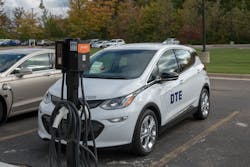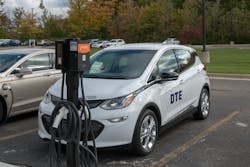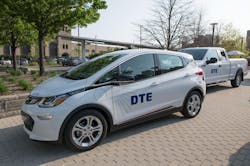Michigan Aims to Be Beating Heart of Electrification
Henry Ford and Ransom E. Olds opened their first auto manufacturing facilities a year apart from one another, in 1898 and 1899, respectively — both in Detroit, Michigan, U.S. Ford closed his factory three years later after producing just three motor vehicles. One might have been forgiven at the time for not seeing the future these milestones would produce, but this was where Michigan became synonymous with the car.
Despite Detroit’s Motor City heritage, Michigan has yet to become a leader in electric vehicles (EVs). In February 2021, the American Council for an Energy-Efficient Economy (ACEEE) ranked Michigan 29th out of 50 states plus Washington, D.C. in a survey of state electrification initiatives. When people think about EVs, they are more likely to think of California, where Tesla Inc. is based. With its policy incentives for charging infrastructure, EV ownership and electric fleets, the Golden State topped ACEEE’s list.
Even though EVs account for only a scant 2% of auto sales, 1.5 million EVs are now on the road in the U.S. Range anxiety, which is the unfamiliarity Americans have about where they can plug in an electric car, is a factor limiting growth as is the fact gas-powered cars are cheaper. According to DTE Energy, Michigan currently has about 24,000 registered EVs.
Public policies designed to spur EV use are not the only way to get more EVs on roads, but they are a tried-and-true method of success. Two Michiganders who are pushing for more EV-promoting policies are current Michigan Gov. Gretchen Whitmer and former Michigan Gov. Jennifer Granholm, who now heads up President Joe Biden’s DOE.
Eye On Electrification
Through a February 2020 executive order, Whitmer created the Michigan Council on Future Mobility and Electrification (CFME) to develop public policy recommendations on electrifying the transportation sector. Michigan already has a lot going for it, according to a 2020 report by the CFME, including the nation’s largest concentration of private-sector facilities, a robust network of universities as well as state agencies.
“Our state has experienced an increase in manufacturing jobs over the last decade,” according to an executive summary of the CFME report. “This demonstrates that Michigan continues to be the global leader in the mobility sector. With the right investments, our state is well positioned to continue to attract and retain the jobs of the future.”
While deindustrialization hit the Great Lakes states hard, the CFME asserts Detroit is still very much the Motor City, and Michigan is home to 24 light-duty original equipment manufacturer headquarters and technology centers. Combined, these contribute US$225 billion to the state economy. Michigan still builds nearly 2 million vehicles per year, and 11% of all North American vehicle production takes place in the state, according to the CFME. Since the Great Recession, auto manufacturing jobs have grown in Michigan by 10%, from 2015 to 2019.
Electrification Policies
“The emerging EV revolution creates a risk that critical supply chains may develop outside the United States. The global battery arms race started years ago, and the U.S. is behind,” according to the CFME.
This is a concern shared by the Biden administration and Granholm’s DOE.
“A low-carbon recovery plan could create 1.7 million new jobs in the U.S. State automakers like Ford and General Motors are producing a greater number of EVs, but policy incentives are needed to ensure that the cost-saving and environmental benefits are available to everyone,” Granholm wrote in a 2020 editorial in the Detroit News.
Biden has released his American Jobs Plan, a $2.3 trillion laundry list of infrastructure and jobs policies, and EV investment is a cornerstone. It calls for a $174 billion emphasis on EVs, which includes putting money into research and development as well as rebates for EV buyers, converting the federal vehicle fleet to zero-emission vehicles like EVs and installing half a million charging stations. The White House says these investments would “create good-paying, union jobs and enable a clean transportation future.”
“The commitments we’ve made must become real,” Biden said at a virtual meeting of Leaders Summit on Climate in April 2021. “Commitment without doing anything is a lot of hot air, no pun intended.”
Gov. Whitmer’s MI Healthy Climate Plan sets a goal of statewide decarbonization by 2050 and a 28% reduction below 1990 levels in greenhouse gas emissions by 2025. Nine other states are working along similar timelines as are Consumers Energy and DTE Energy, the state’s two largest utilities, and Detroit’s General Motors.
EV Pilot Programs
In Lansing, the Michigan Public Service Commission (MPSC) has been hosting technical conferences and circulating information on EVs since about 2017. The MPSC approved two EV pilot program phases for DTE Electric Co., two for Consumers Energy and another for Indiana Michigan Power.
The first phase of DTE Electric’s Charging Forward program was approved by the PSC in May 2019 and launched in June 2019. The second phase, focused on fleets, was approved in March 2021. About $27.5 million will be spent through 2025“The commission anticipates many expected benefits of DTE Electric’s phase two proposal, including improved total cost of ownership to participating customers, improved grid utilization, reduced emissions and a more favorable business environment in Michigan,” according to a release from the March 19, 2021, meeting of the MPSC in Lansing. “Moreover, the continued growth of EV adoption and carbon reduction is consistent with Gov. Gretchen Whitmer’s MI Healthy Climate Plan, as announced in Executive Directive 2020-10 and Executive Order 2020-182.”
The first phase of the pilot program offers residential Level 2 charger rebates as well as public Level 2 and direct-current (dc) fast-charging infrastructure enablement incentives to help kick-start a charging network crisscrossing Michigan. The commission approved the program to test technology innovations, rate designs, customer response and other factors. Data from these pilot programs will help utilities and the MPSC to make more informed decisions on how to address challenges and value the potential benefits associated with increased electric load from residential and commercial customer-owned EVs.
Angela M. Meriedeth, spokesperson for DTE Energy, said one thing the utility has learned so far is EV-owning customers do change their electricity consumption habits when given the incentive.
“DTE did have prior EV pilots that tested EV-specific residential time-of-use (TOU) electric rates. Our past pilots confirmed TOU rates do encourage EV owners to charge during off-peak times and helped set the groundwork for components of Charging Forward,” Meriedeth noted.
Charging Forward provides residential customers $500 rebates for qualified Level 2 chargers and business customers $2,500 per Level 2 port and up to $55,000 per dc fast charger.
“Our goals with Charging Forward are to efficiently integrate EV load with the DTE Electric distribution system, thus providing benefits to all customers, to help customers understand the potential benefits of EVs, to reduce barriers to EV adoption, to participate in infrastructure deployment through thoughtful partnerships and to test new technologies,” Meriedeth said.
The utility also plans to study vehicle-to-grid (V2G) technology, where grid-networked fleets of EVs return power to the grid or alter their charging schedules as needed.
“We do have plans to have a V2G study in tandem with our eBus deployment. The V2G study will provide valuable learning on the effects of energy efficiency and the capabilities of the bus that are mutually beneficial for the school and the environment, such as the ability for the bus battery to provide energy to the school during a power outage,” Meriedeth said.
The results of the study will be used to develop programs that further benefit schools based on EV bus capabilities, she added.
Tremaine L. Phillips, one of three members of the MPSC, said Consumers Energy is testing out a nighttime savers rate for EVs, another TOU-style project. Consumers Energy also offers rebates as part of its PowerMIDrive program. For residential customers installing an at-home Level 2 charger, Consumers Energy will offer a $500-per-vehicle rebate for participating ratepayers. For dc fast chargers, the utility offers up to a $70,000 rebate. Consumers Energy estimates the program cost at $10 million, half of which will be spent in the first year, according to Phillips.
“PowerMIDrive is estimated to provide a net benefit to the grid of approximately $2,000 per electric vehicle. Doubling the numbers of EVs in its service territory during the pilot could bring a gross system benefit of $15 million to $18 million,” Phillips said.
The MPSC approved a slightly different kind of EV pilot for Indiana Michigan Power, another utility with an EV program and service territory in Michigan. The utility uses a plug-in EV charging tariff, Phillips noted.
“The new tariff change does not change rates but rather adds a submetering option, which allows the utility to measure EV charging load separate from the customer’s overall load,” Phillips explained. “The customer’s bill will now include an adjustment based on TOU calculations for when they charge their EV. This charging data will be collected and analyzed for Indiana Michigan’s next rate case.”
Proper Planning
Phillips said these pilots will test technology innovations, rate design and customer response as well as provide utilities and regulators with valuable insights on how to make the most of EV technology.
“Pilot program data and lessons learned will help position the utilities and the MPSC to make more informed decisions over the long term — demonstrating EV pilot programs while Michigan-wide EV adoption is still low,” Phillips said.
This experience will be essential to proper planning. Low EV use in Michigan right now means no serious power grid impacts, but managing grid impacts correctly in the future will result in more efficient use of power grid assets, Phillips noted.
“Additionally, EV batteries have the potential to serve a vital role for energy storage in the future, which, if understood and implemented properly, could lead to additional benefits for ratepayers,” Phillips said.
According to him, the second phase of DTE’s Charging Forward program is now fully subscribed and will promote EV adoption through commercial and industrial fleet electrification.
“The second phase will establish an education and outreach plan targeted to Michigan's commercial fleet operators on the benefits of electrification, provide support for fleet operators looking to electrify their fleets, and fund service connection upgrades and credits toward customer-owned contribution in aid of construction as well as rebates for charging infrastructure,” Phillips said.
Powering The Future
Michigan’s utilities and regulators believe the state has the potential to become well known for its EV integration if electrification is carried out with good planning, executed with the right price signals and properly coordinated with charging station vendors.
Phillips said his father’s first job opportunity more than 40 years ago was with General Motors, and he has continued to work in the auto industry as an electrical engineer. That job that brought his family to Michigan in the first place.
“So, I am intimately familiar with the unique attributes Michigan possesses that will assist in the acceleration of the [Biden] administration and Department of Energy’s ambitious decarbonization and electric vehicle adoption goals, and I know that Secretary Granholm has great knowledge of these attributes, as well. Not only is Michigan the auto manufacturing capital of the world, but we are also the global hub for automobile innovation, supply chain, post-secondary education and financing” he said.
Phillips said with almost 100 new EV models planned between now and 2025 by General Motors, Ford and other automakers, the road to electrification in the U.S. and around the world must drive through metro Detroit and the state of Michigan.
About the Author
Jeff Postelwait
Managing Editor
Jeff Postelwait is a writer and editor with a background in newspapers and online editing who has been writing about the electric utility industry since 2008. Jeff is senior editor for T&D World magazine and sits on the advisory board of the T&D World Conference and Exhibition. Utility Products, Power Engineering, Powergrid International and Electric Light & Power are some of the other publications in which Jeff's work has been featured. Jeff received his degree in journalism news editing from Oklahoma State University and currently operates out of Oregon.



